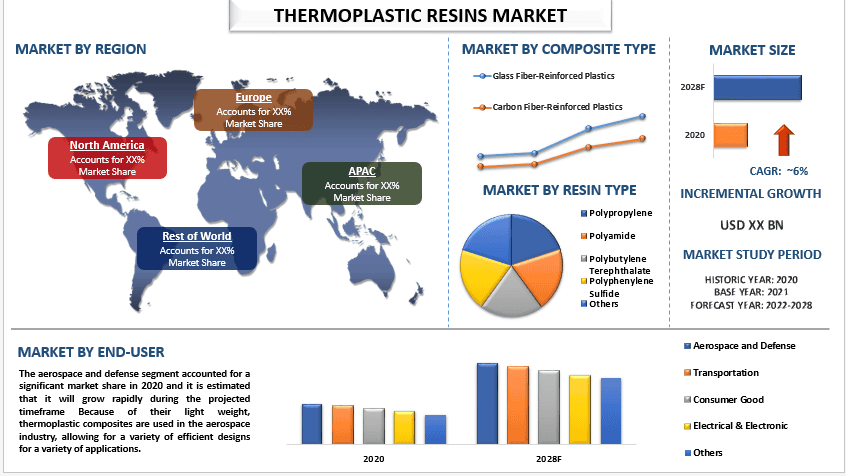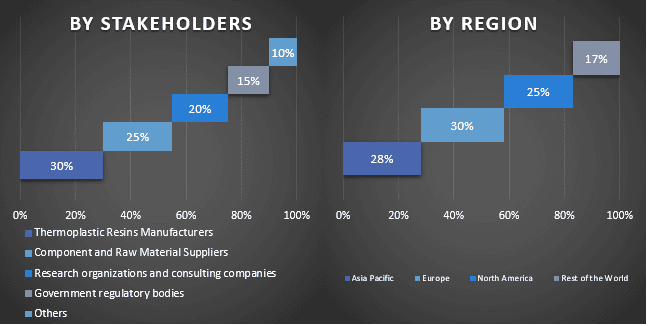
预计热塑性树脂市场在 2022-2028 年期间的复合年增长率约为 6%。 热塑性树脂本质上用途广泛,可以重塑,只会发生物理变化而不是化学变化。热塑性塑料是未成形的原材料,加热时会熔化,冷却时会凝固。它们可以多次重熔和重塑,从而可以对零件进行再加工。它们改变形状和回收利用的能力以及对环境的友好性推动了市场增长。制造过程在环境上是可持续的,并且只需要少量投资。热塑性塑料可以承受高水平的冲击;它们的抗冲击性几乎是同类产品的十倍。这一特性促使了防弹背心、飞机窗户和头盔面罩等应用。对热塑性树脂日益增长的需求可归因于建筑、汽车以及电气和电子行业对产品需求的不断增长,因此,全球主要行业参与者越来越多地采用有机增长战略。例如,2019 年 5 月,Polyone Corporation 在 CHINAPLAS 2019 上推出了新的热塑性复合材料产品。它推出了 Complet LFT 配方,这是一种以 PEEK 和 PP 为基础树脂的热塑性复合材料,以满足高度苛刻的设计和性能要求。由于人口增长及其对汽车和其他产品的偏好所带来的明显统计数据,全球对热塑性树脂的需求得到提振,并将有助于未来一段时间的市场增长。此外,由于 COVID-19 病例的增加,个人防护设备 (PPE)(如口罩、面罩、医用长袍和各种医疗设备)的产量不断增加,预计热塑性树脂市场将因医疗保健行业的产品消费增加而增长。此外,各国政府在建筑行业支出的增加是推动市场增长的一个重要因素。然而,市场上的一些限制因素,包括原材料成本高昂,正在阻碍该市场在全球范围内的增长。
巴斯夫公司 (BASF SE)、塞拉尼斯公司 (Celenase Corporation)、朗盛公司 (Lanxess AG)、索尔维公司 (Solvay S.A)、三菱化学先进材料公司 (Mitsubishi Chemical Advanced Materials)、东丽工业株式会社 (Toray Industries, Inc.)、宝理公司 (Polyone Corporation)、利安德巴塞尔工业公司 (LyondellBasell Industries N.V.)、EMS-GRIVORY、英力士 (INEOS) 是市场中的一些主要参与者。这些公司已经进行了多次并购以及合作,以便为客户提供高科技和创新产品/技术。
报告中提出的见解
“在树脂类型中,聚苯硫醚类别在 2020 年占据了市场的重要份额”
根据树脂类型,热塑性树脂市场分为聚丙烯、聚酰胺、聚对苯二甲酸丁二醇酯、聚苯硫醚和其他。聚苯硫醚细分市场占据了显着的市场份额,据估计在预计的时间范围内它将快速增长。由于聚酰胺在包括国防、航空航天和汽车在内的众多行业中的应用不断增长,预计聚酰胺细分市场在收入方面将占据最大的市场份额。由于其出色的耐磨性和延展性,聚酰胺基材料对于汽车应用尤其有利。
“在化合物中,预计短纤维增强热塑性塑料类别在预测期内将占据重要份额”
根据化合物,市场分为短纤维增强热塑性塑料、长纤维增强热塑性塑料、连续纤维增强热塑性塑料和玻璃毡增强热塑性塑料。短纤维增强热塑性塑料细分市场占据了相当大的市场份额,预计在预测期内将以显着的复合年增长率增长。它们用于需要长保质期、高产量和耐用性的应用中。
“在复合材料类型中,预计玻璃纤维增强塑料类别在预测期内将占据相当大的市场份额”
根据复合材料类型,市场分为玻璃纤维增强塑料和碳纤维增强塑料。玻璃纤维增强塑料细分市场占据了相当大的市场份额,预计在预测期内将以显着的复合年增长率增长,这归功于其在风能、运输、消费电子、建筑和其他行业的各种用途。玻璃纤维因其低成本和能够与各种树脂一起加工而需求量很大。
“在最终用户中,预计航空航天和国防类别在预测期内将占据相当大的市场份额”
根据最终用户,市场分为航空航天和国防、运输、消费品、电气和电子以及其他。航空航天和国防细分市场占据了相当大的市场份额,预计在预测期内将以显着的复合年增长率增长。由于其重量轻,热塑性复合材料被用于航空航天工业,从而可以为各种应用提供各种高效设计。
“亚太地区预计在预测期内将出现显着增长”
为了更好地了解热塑性树脂的市场采用情况,该市场根据其在世界各地的存在情况进行分析,这些国家包括北美(美国、加拿大和北美其他地区)、欧洲(德国、法国、意大利、西班牙、英国和欧洲其他地区)、亚太地区(中国、日本、印度、澳大利亚和亚太地区其他地区)和世界其他地区。亚太地区是热塑性树脂行业的主要市场,这归功于商用车和乘用车的产量高、制造单位的增加以及电子制造业的持续增长。中国的塑料产能几乎占世界塑料产能的四分之一,拥有超过 15,000 家塑料工厂。
购买本报告的理由:
- 该研究包括经过认证的主要行业专家验证的市场规模和预测分析。
- 该报告快速回顾了一目了然的整体行业绩效。
- 该报告涵盖了对主要行业同行深入分析,主要侧重于关键业务财务、产品组合、扩张战略和最新发展。
- 详细检查行业中存在的驱动因素、限制因素、关键趋势和机遇。
- 该研究全面涵盖了跨不同细分市场的市场。
- 深入的行业区域层面分析。
定制选项:
全球热塑性树脂市场可以根据要求或任何其他细分市场进一步定制。除此之外,UMI 理解您可能拥有自己的业务需求,因此请随时与我们联系以获取完全符合您要求的报告。
目录
全球热塑性树脂市场分析(2022-2028)的研究方法
分析历史市场、评估当前市场以及预测全球热塑性树脂市场的未来市场是创建和分析全球主要地区热塑性树脂采用情况的三个主要步骤。进行了详尽的二级研究,以收集历史市场数据并评估当前市场规模。其次,为了验证这些见解,考虑了许多发现和假设。此外,还与全球热塑性树脂市场价值链中的行业专家进行了详尽的初步访谈。在通过初步访谈对市场数据进行假设和验证后,我们采用了自上而下/自下而上的方法来预测完整的市场规模。此后,采用市场细分和数据三角测量方法来评估和分析行业相关细分市场和子细分市场的市场规模。详细方法如下所述:
历史市场规模分析
步骤 1:深入研究二级来源:
进行了详细的二级研究,通过公司内部来源(如年度报告和财务报表、业绩演示文稿、新闻稿等)以及外部来源(包括期刊、新闻和文章、政府出版物、竞争对手出版物、行业报告、第三方数据库和其他可靠的出版物)获取热塑性树脂市场的历史市场规模。
步骤 2:市场细分:
在获得热塑性树脂市场的历史市场规模后,我们进行了详细的二级分析,以收集主要地区不同细分市场和子细分市场的历史市场洞察和份额。报告中包含的主要细分市场包括树脂类型、化合物、复合材料类型和最终用户。此外,还进行了国家层面的分析,以评估该地区测试模型的总体采用情况。
步骤 3:因素分析:
在获得不同细分市场和子细分市场的历史市场规模后,我们进行了详细的因素分析,以评估热塑性树脂市场的当前市场规模。此外,我们使用因变量和自变量进行因素分析,例如,对热塑性树脂日益增长的需求可归因于建筑、汽车以及电气和电子行业等全球产品需求的增长。对需求和供应方情景进行了彻底的分析,考虑了全球热塑性树脂市场领域的顶级合作伙伴关系、并购、业务扩张和产品发布。
当前市场规模评估与预测
当前市场规模:基于上述 3 个步骤的可行见解,我们得出了当前市场规模、全球热塑性树脂市场的关键参与者以及细分市场的市场份额。所有必需的百分比份额分配和市场细分均使用上述二级方法确定,并通过初步访谈进行验证。
评估与预测:对于市场评估和预测,为包括驱动因素和趋势、制约因素以及利益相关者可获得的机会在内的不同因素分配了权重。在分析这些因素后,应用相关的预测技术,即自上而下/自下而上的方法,以得出全球主要市场中不同细分市场和子细分市场约 2027 年的市场预测。用于评估市场规模的研究方法包括:
- 该行业的市场规模,以收入(美元)以及国内主要市场中热塑性树脂市场的采用率计算
- 市场细分和子细分的全部百分比份额、分配和细分
- 全球热塑性树脂市场中提供解决方案的关键参与者。此外,这些参与者为在快速增长的市场中竞争而采取的增长战略
市场规模和份额验证
初步研究:与主要地区的关键意见领袖 (KOL)(包括高层管理人员(CXO/VP、销售主管、营销主管、运营主管和区域主管、国家主管等))进行了深入访谈。然后总结初步研究结果,并进行统计分析以证明既定的假设。初步研究的投入与二级研究结果相结合,从而将信息转化为可行见解。
不同地区主要参与者拆分

市场工程
采用数据三角测量技术来完成整体市场评估,并得出全球热塑性树脂市场各细分市场和子细分市场的精确统计数字。在研究全球热塑性树脂市场中树脂类型、化合物、复合材料类型和最终用户等领域的各种参数和趋势后,将数据拆分为多个细分市场和子细分市场。
全球热塑性树脂市场研究的主要目标
该研究明确指出了全球热塑性树脂市场的当前和未来市场趋势。投资者可以获得战略见解,从而根据研究中进行的定性和定量分析来确定其投资判断。当前和未来市场趋势确定了区域层面的市场整体吸引力,为行业参与者提供了一个利用未开发市场以获得先发优势的平台。研究的其他定量目标包括:
- 分析热塑性树脂市场当前和预测的市场规模,以价值(美元)计算。此外,分析不同细分市场和子细分市场当前和预测的市场规模
- 研究中的细分市场包括树脂类型、化合物、复合材料类型和最终用户等领域。
- 定义和分析热塑性树脂市场行业的监管框架。
- 分析涉及各种中介机构的价值链,以及分析行业的客户和竞争对手行为。
- 分析主要地区热塑性树脂市场当前和预测的市场规模。
- 报告中研究的各地区的主要国家包括亚太地区、欧洲、北美和世界其他地区。
- 热塑性树脂市场的公司简介以及市场参与者为在快速增长的市场中保持竞争力而采取的增长战略
- 对行业进行深入的区域层面分析
相关 报告
购买此商品的客户也购买了










